





I have returned from a fabulous SAMSI workshop in Research Triangle Park in North Carolina on Uncertainty Quantification, which I will be writing about in another post (or two).
While there, I managed to visit SAS, since one of my former doctoral students, Dr. Padma Ramanujam, who received a doctoral dissertation award from what is now the Transportation Science & Logistics Society of INFORMS, works there.
I was treated to a superb lunch and we were joined by Dr. Radhika Kulkarni, who is Vice President of Advanced Analytics R&D at SAS, and who has a PhD in Operations Research from Cornell University.
My hosts were wonderful and the newest SAS building where the executives sit and where we had lunch is simply stunning. Above are photos that were taken there and I even managed to snap one of the back of Dr. Jim Goodnight, the co-founder of SAS, whom I had recently highlighted because of the coverage of him as the "Father of Analytics" in a Forbes article.
I know Dr. Kulkarni from INFORMS activities, and we were both recipients of the WORMS Award.
Dr. Kulkarni pointed me to her blogpost in SAS Voices on The Journey to High-Performance Analytics, in which she highlights some of the exciting work that SAS is involved in. Since Macy's is one of my favorite stores and, especially the one on 34th Street in NYC, I repost her description of one of the SAS projects (that, coincidentally, Padma also worked on):
What does high-performance analytics mean for your business? It has the potential to introduce some game changing options for customers. For instance, Macy’s needs to determine optimal clearance prices for over 273 million product-by-location combinations involving hundreds of millions of potential pricing decisions per week. The SAS Markdown Optimization solution analyzes three terabytes of historical sales data with multiple estimation and pricing algorithms targeted for this particular business problem. Using new SAS high-performance computing technologies, the computation time was reduced from 30 hours down to about 2 hours. This immense reduction in time gives the customer an opportunity to run more scenarios in the same window of time, providing the ability to look at alternate pricing strategies, thus allowing Macy’s to provide the right prices to the right customers at the right time, in the end maximizing profit and clearing inventory.
I might add that Dr. Radhika Kulkarni has joined the INFORMS Speakers Program, which is great, along with such luminaries as Dr. Brenda Dietrich of IBM (who, coincidentally, also has a PhD in Operations Research from Cornell), Dr. Mike Trick of CMU, Dr. Les Servi of MITRE (a fellow Brown alum, who then got his PhD from Harvard), and Dr. Anne Robinson, a Stanford PhD, of Cisco. INFORMS is in the process of updating the Speakers Program pages, so stay tuned.
Now, for the punchline -- and in the title of this blogpost -- those of you who are on the job market and are thinking of industry. You have passed the core and comprehensive exams, and your doctoral dissertation proposal defense, and are finishing up the writing of your dissertations.
The job interview requests are starting to come in.
Who would have thought that a job interview might entail, and, in industry, no less, that you prove theorems?!
Well, Dr. Padma Ramanujam, after getting her PhD from UMass Amherst, with a concentration in Management Science, receiving a national dissertation award, and even co-authoring a book with me and another student of mine, Dr. Kanwalroop "Kathy" Dhanda, on Environmental Networks, and having several years of work experience at I2 Technologies, made it through the SAS interview process. She told me, during my visit to SAS, that one of her interviewers had asked her to prove theorems, which she did and she got the job offer!
The SAS "campus" is gorgeous so, if you have a chance to visit, you will not be disappointed.


















